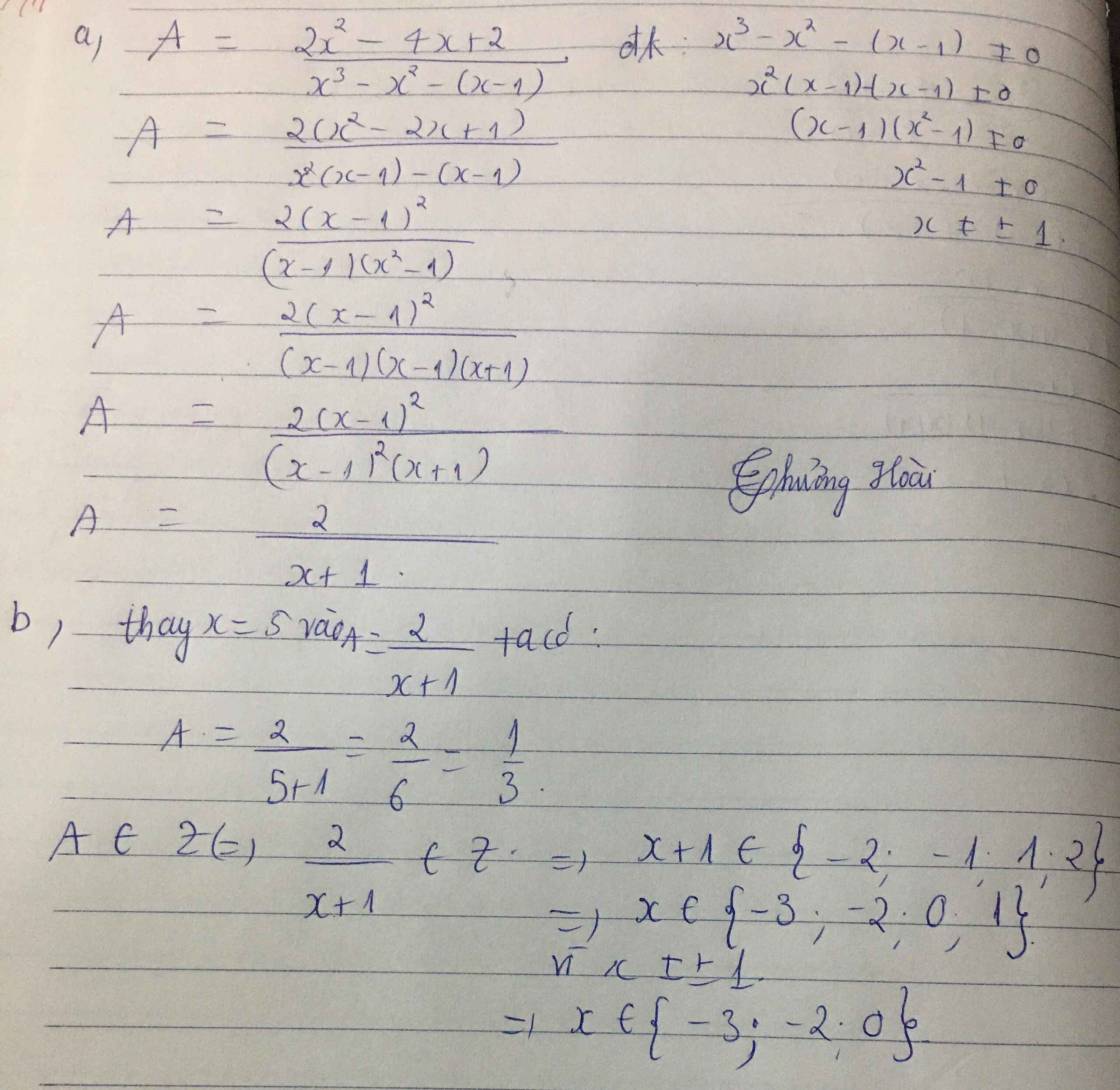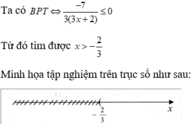Hãy nhập câu hỏi của bạn vào đây, nếu là tài khoản VIP, bạn sẽ được ưu tiên trả lời.

a) Ta có: A = \(\frac{x+1}{x-2}+\frac{x-1}{x+2}+\frac{x^2+4x}{4-x^2}\)
A = \(\frac{\left(x+1\right)\left(x+2\right)}{\left(x-2\right)\left(x+2\right)}+\frac{\left(x-1\right)\left(x-2\right)}{\left(x+2\right)\left(x-2\right)}-\frac{x^2+4x}{\left(x-2\right)\left(x+2\right)}\)
A = \(\frac{x^2+3x+2+x^2-3x+2-x^2-4x}{\left(x-2\right)\left(x+2\right)}\)
A = \(\frac{x^2-4x+4}{\left(x-2\right)\left(x+2\right)}\)
A = \(\frac{\left(x-2\right)^2}{\left(x-2\right)\left(x+2\right)}=\frac{x-2}{x+2}\)
b) Với x = 4 => A = \(\frac{4-2}{4+2}=\frac{2}{8}=\frac{1}{4}\)
c) ĐKXĐ: \(\hept{\begin{cases}x-2\ne0\\x+2\ne0\\4-x^2\ne0\end{cases}}\) <=> \(\hept{\begin{cases}x\ne2\\x\ne-2\\x\ne\pm2\end{cases}}\) <=> \(x\ne\pm2\)
Ta có: A = \(\frac{x-2}{x+2}=\frac{\left(x+2\right)-4}{x+2}=1-\frac{4}{x+2}\)
Để A nhận giá trị nguyên dương <=> \(1-\frac{4}{x+2}\) nguyên dương
<=> \(-\frac{4}{x+2}\) nguyên dương <=> -4 \(⋮\)x + 2
<=> x + 2 \(\in\)Ư(-4) = {1; -1; 2; -2; 4; -4}
Lập bảng:
| x + 2 | 1 | -1 | 2 | -2 | 4 | -4 |
| x | -1(tm) | -3(tm) | 0(tm) | -4(tm) | 2(ktm) | -6(tm) |
Vậy ....

a, ĐKXĐ: x\(\ne\) 1;-1;2
b, A= \(\left(\frac{x}{x+1}+\frac{1}{x-1}-\frac{4x}{2-2x^2}\right):\frac{x+1}{x-2}\)
=\(\left(\frac{2x^2-2x}{2\left(x+1\right)\left(x-1\right)}+\frac{2x+2}{2\left(x+1\right)\left(x-1\right)}+\frac{4x}{2\left(x-1\right)\left(x+1\right)}\right)\times\frac{x-2}{x+1}\)
=\(\frac{2x^2-2x+2x+2+4x}{2\left(x+1\right)\left(x-1\right)}\times\frac{x-2}{x+1}\)
=\(\frac{2x^2+4x+2}{2\left(x+1\right)\left(x-1\right)}\times\frac{x-2}{x+1}\)
=\(\frac{2\left(x+1\right)^2}{2\left(x+1\right)\left(x-1\right)}\times\frac{x-2}{x+1}\)
=\(\frac{x-2}{x-1}\)
c, Khi x= -1
→A= \(\frac{-1-2}{-1-1}\)
= -3
Vậy khi x= -1 thì A= -3
Câu d thì mình đang suy nghĩ nhé, mình sẽ quay lại trả lời sau ^^
a,ĐKXĐ:x#1; x#-1; x#2
b,Ta có:
A=\(\left(\frac{x}{x+1}+\frac{1}{x-1}-\frac{4x}{2-2x^2}\right):\frac{x+1}{x-2}\)
=\(\left(\frac{x\left(x-1\right)2}{\left(x+1\right)\left(x-1\right)2}+\frac{\left(x+1\right)2}{\left(x-1\right)\left(x+1\right)2}+\frac{4x}{2\left(x-1\right)\left(x+1\right)}\right):\frac{x+1}{x-2}\)
=\(\frac{2x^2-2x+2x+2+4x}{\left(x+1\right)\left(x-1\right)2}.\frac{x-2}{x+1}\)
=\(\frac{2x^2+4x+2}{\left(x+1\right)\left(x-1\right)2}.\frac{x-2}{x+1}\)
=\(\frac{2\left(x+1\right)^2}{\left(x+1\right)\left(x-1\right)2}.\frac{x-2}{x+1}\)
=\(\frac{x-2}{x+1}\)
c,Tại x=-1 ,theo ĐKXĐ x#-1 \(\Rightarrow\)A không có kết quả
d,Để A có giá trị nguyên \(\Rightarrow\frac{x-2}{x+1}\)có giá trị nguyên
\(\Leftrightarrow x-2⋮x+1\)
\(\Leftrightarrow x+1-3⋮x+1\)
Mà \(x+1⋮x+1\Rightarrow3⋮x+1\)
\(\Rightarrow x+1\inƯ\left(3\right)=\left\{1;-1;3;-3\right\}\)
\(\Rightarrow x\in\left\{0;-2;2;-4\right\}\)
Mà theo ĐKXĐ x#2\(\Rightarrow x\in\left\{0;-2;-4\right\}\)
Vậy \(x\in\left\{0;-2;-4\right\}\)thì a là số nguyên

a: \(B=\left(\dfrac{x}{\left(x-2\right)\left(x+2\right)}-\dfrac{2}{x-2}+\dfrac{1}{x+2}\right):\left(x-2+\dfrac{10-x^2}{x+2}\right)\)
\(=\dfrac{x-2x-4+x-2}{\left(x-2\right)\left(x+2\right)}:\dfrac{x^2-4+10-x^2}{x+2}\)
\(=\dfrac{-6}{\left(x-2\right)\left(x+2\right)}\cdot\dfrac{x+2}{6}=\dfrac{-1}{x-2}\)
b: Khi x=1/2 thì \(B=\dfrac{-1}{\dfrac{1}{2}-2}=\dfrac{2}{3}\)
Khi x=-1/2 thì B=2/5
c: Để B nguyên thì \(x-2\in\left\{1;-1\right\}\)
hay \(x\in\left\{3;1\right\}\)
a, đk : x khác -2 ; 2
\(B=\left(\dfrac{x-2\left(x+2\right)+x-2}{\left(x-2\right)\left(x+2\right)}\right):\left(\dfrac{x^2-4+10-x^2}{x+2}\right)\)
\(=\dfrac{-6}{\left(x-2\right)\left(x+2\right)}:\dfrac{6}{x+2}=\dfrac{1}{2-x}\)
b, Ta có \(\left|x\right|=\dfrac{1}{2}\Leftrightarrow x=\dfrac{1}{2};x=-\dfrac{1}{2}\)
Với x = 1/2 ta được \(B=\dfrac{1}{2-\dfrac{1}{2}}=\dfrac{2}{3}\)
Với x = -1/2 ta được \(B=\dfrac{1}{2+\dfrac{1}{2}}=\dfrac{2}{5}\)
c, \(\dfrac{1}{2-x}\Rightarrow2-x\inƯ\left(1\right)=\left\{\pm1\right\}\)
| 2-x | 1 | -1 |
| x | 1 | 3 |

Bài 1 :
a, \(A=\frac{2x^2-4x+8}{x^3+8}=\frac{2\left(x^2-2x+4\right)}{\left(x+2\right)\left(x^2-2x+4\right)}=\frac{2}{x+2}\)
b, Ta có : \(\left|x\right|=2\Rightarrow\orbr{\begin{cases}x=2\\x=-2\end{cases}}\)
TH1 : Thay x = 2 vào biểu thức trên ta được :
\(\frac{2}{2+2}=\frac{2}{4}=\frac{1}{2}\)
TH2 : Thay x = -2 vào biểu thức trên ta được :
\(\frac{2}{-2+2}=\frac{2}{0}\)vô lí
c, ta có A = 2 hay \(\frac{2}{x+2}=2\)ĐK : \(x\ne-2\)
\(\Rightarrow2x+4=2\Leftrightarrow2x=-2\Leftrightarrow x=-1\)
Vậy với x = -1 thì A = 2
d, Ta có A < 0 hay \(\frac{2}{x+2}< 0\)
\(\Rightarrow x+2< 0\)do 2 > 0
\(\Leftrightarrow x< -2\)
Vậy với A < 0 thì x < -2
e, Để A nhận giá trị nguyên khi \(x+2\inƯ\left(2\right)=\left\{\pm1;\pm2\right\}\)
| x + 2 | 1 | -1 | 2 | -2 |
| x | -1 | -3 | 0 | -4 |
2.
ĐKXĐ : \(x\ne\pm2\)
a. \(B=\frac{x^2-4x+4}{x^2-4}=\frac{\left(x-2\right)^2}{\left(x-2\right)\left(x+2\right)}=\frac{x-2}{x+2}\)
b. | x - 1 | = 2 <=>\(\hept{\begin{cases}x-1=2\\x-1=-2\end{cases}}\)<=>\(\hept{\begin{cases}x=3\\x=-1\end{cases}}\)
Với x = 3 thì \(B=\frac{3-2}{3+2}=\frac{1}{5}\)
Với x = - 1 thì \(B=\frac{-1-2}{-1+2}=-3\)
Vậy với | x - 1 | = 2 thì B đạt được 2 giá trị là B = 1/5 hoặc B = - 3
c. \(B=\frac{x-2}{x+2}=-1\)<=>\(-\left(x-2\right)=x+2\)
<=> \(-x+2=x+2\)<=>\(-x=x\)<=>\(x=0\)
d. \(B=\frac{x-2}{x+2}< 1\)<=>\(x-2< x+2\)luôn đúng \(\forall\)x\(\ne\pm2\)
e. \(B=\frac{x-2}{x+2}=\frac{x+2-4}{x+2}=1-\frac{4}{x+2}\)
Để B nguyên thì 4/x+2 nguyên => x + 2\(\in\){ - 4 ; - 2 ; - 1 ; 1 ; 2 ; 4 }
=> x \(\in\){ - 6 ; - 4 ; - 3 ; - 1 ; 0 ; 2 }


a. \(A=\dfrac{1}{x-1}-\dfrac{1}{x+1}+\dfrac{4x+2}{x^2-1}\)
\(A=\dfrac{x+1}{\left(x-1\right)\left(x+1\right)}-\dfrac{x-1}{\left(x-1\right)\left(x+1\right)}+\dfrac{4x+2}{\left(x-1\right)\left(x+1\right)}\)
\(A=\dfrac{\left(x+1\right)-\left(x-1\right)+4x+2}{\left(x-1\right)\left(x+1\right)}\)
\(A=\dfrac{x+1-x+1+4x+2}{\left(x-1\right)\left(x+1\right)}\)
\(A=\dfrac{4x+4}{\left(x-1\right)\left(x+1\right)}=\dfrac{4\left(x+1\right)}{\left(x-1\right)\left(x+1\right)}=\dfrac{4}{x-1}\)
b) Ta có: \(A=\dfrac{4}{x-1}=\dfrac{4}{2015}\) (ĐK: \(x\ne\pm1\) )
\(\Leftrightarrow8060=4\left(x-1\right)\)
\(\Leftrightarrow8060=4x-4\)
\(\Leftrightarrow8064=4x\)
\(\Leftrightarrow x=\dfrac{8064}{4}=2016\left(tm\right)\)
c) Ta có: \(\dfrac{4}{x-1}\left(x\ne1\right)\)
Để \(\dfrac{4}{x-1}\) nhận giá trị nguyên thì \(4:\left(x-1\right)\Leftrightarrow x-1\in\text{Ư}\left(4\right)=\left\{1;4;2\right\}\)
Vậy với x ∈ {2; 5; 3; 0; -1; -3} thì biểu thức \(\dfrac{4}{x-1}\) nhận giá trị nguyên
d) Thay \(x=-\dfrac{1}{2}\) vào biểu thức A ta được:
\(\dfrac{4}{-\dfrac{1}{2}-1}=-3\)
Vậy biểu thức A có giá trị -3 tại \(x=-\dfrac{1}{2}\)